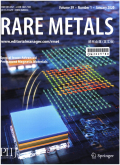- 钛学术文献服务平台 \
- 学术期刊 \
- 工业技术期刊 \
- 冶金工业期刊 \
- 稀有金属(英文版)期刊 \
Low-field magnetoresistance of (1-x)La_(0.6)Dy_(0.1)Sr_(0.3)MnO_3/0.5x (Sb_2O_3) composite system under different sintering temperatures of matrix
Low-field magnetoresistance of (1-x)La_(0.6)Dy_(0.1)Sr_(0.3)MnO_3/0.5x (Sb_2O_3) composite system under different sintering temperatures of matrix
基本信息来源于合作网站,原文需代理用户跳转至来源网站获取
摘要:
A series of (1-x)La0.6Dy0.1Sr0.3MnO3/0.5x(Sb2O3)(x=0.15) samples were prepared by the solid-state reaction method, and the influence of sintering temperature of the matrix on low-field magnetoresistance of (1-x)La0.6Dy0.1Sr0.3MnO3/0.5x (Sb2O3) was studied through the measurements of X-ray diffraction (XRD) patterns, scanning electron microscope (SEM) image, resistivity-temperature (ρ-T) curves, and magnetoresistance-temperature (MR-T) curves. The results indicate that for the samples with low sintering temperature of the matrix, lowfield magnetoresistance effect appears on the whole temperature range and can be explained by grain boundary effect; for the sample with high sintering temperature of the matrix, intrinsic magnetoresistance peak appears on the high-temperature range, low-field magnetore-sistance effect appears on low temperature range, and the magnetoresistance in the magnetic field of 0.2 T and on the comparatively large temperature range between 280 K and 225 K hardly changes with temperature and remains at 4.8%, which can be explained by the competition between the intrinsic magnetoresistance induced by double-exchange function inside grains and the tunneling magnetoresis-tance (TMR) induced by grain boundary effect. The temperature stability of magnetoresistance is beneficial to the practical applications of MR.

推荐文章
喷涂条件与热处理对La_(0.5)Sr_(0.5)CoO_(3-δ)层含氧量的影响
La_(0.5)Sr_(0.5)CoO_(3-δ)等离子喷涂
火焰喷涂
含氧量
碘滴定法
La1-xCaxMn0.96Fe0.04O3(x=0.31、0.5、0.6)的中子衍射研究
中子粉末衍射
晶体结构
磁结构
La_(1-x)Sr_xMnO_3电极的制备及其对Ba_(1-x)Sr_xTiO_3薄膜介电性能的影响
溶胶-凝胶技术
La_(1-x)Sr_xMnO_3电极
Ba_(1-x)Sr_xTiO_3
外延生长
介电性能
自蔓延高温合成SOFC阴极材料La0.7Sr0.3MnO3
自蔓延高温合成
燃料电池
阴极材料
La0.7Sr0.3MnO3
内容分析
关键词云
关键词热度
相关文献总数
(/次)
(/年)
引文网络
引文网络
二级参考文献 (0)
共引文献 (0)
参考文献 (0)
节点文献
引证文献 (0)
同被引文献 (0)
二级引证文献 (0)
2012(0)
- 参考文献(0)
- 二级参考文献(0)
- 引证文献(0)
- 二级引证文献(0)
引文网络交叉学科
相关学者/机构
期刊影响力
稀有金属(英文版)
主办单位:
中国有色金属学会
出版周期:
月刊
ISSN:
1001-0521
CN:
11-2112/TF
开本:
16开
出版地:
北京学院路2号
邮发代号:
创刊时间:
1989
语种:
eng
出版文献量(篇)
2804
总下载数(次)
0
总被引数(次)
9706
期刊文献
相关文献
推荐文献
- 期刊分类
- 期刊(年)
- 期刊(期)
- 期刊推荐
一般工业技术
交通运输
军事科技
冶金工业
动力工程
化学工业
原子能技术
大学学报
建筑科学
无线电电子学与电信技术
机械与仪表工业
水利工程
环境科学与安全科学
电工技术
石油与天然气工业
矿业工程
自动化技术与计算机技术
航空航天
轻工业与手工业
金属学与金属工艺
稀有金属(英文版)2022
稀有金属(英文版)2021
稀有金属(英文版)2020
稀有金属(英文版)2019
稀有金属(英文版)2018
稀有金属(英文版)2017
稀有金属(英文版)2016
稀有金属(英文版)2015
稀有金属(英文版)2014
稀有金属(英文版)2013
稀有金属(英文版)2012
稀有金属(英文版)2011
稀有金属(英文版)2010
稀有金属(英文版)2009
稀有金属(英文版)2008
稀有金属(英文版)2007
稀有金属(英文版)2006
稀有金属(英文版)2005
稀有金属(英文版)2004
稀有金属(英文版)2003
稀有金属(英文版)2002
稀有金属(英文版)2001
稀有金属(英文版)2000
稀有金属(英文版)1999
稀有金属(英文版)2012年第6期
稀有金属(英文版)2012年第5期
稀有金属(英文版)2012年第4期
稀有金属(英文版)2012年第3期
稀有金属(英文版)2012年第2期
稀有金属(英文版)2012年第1期

 免费查重
免费查重










